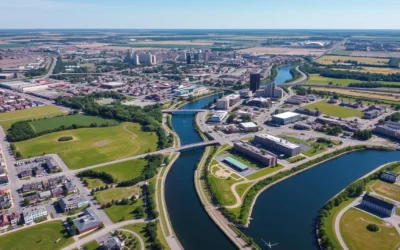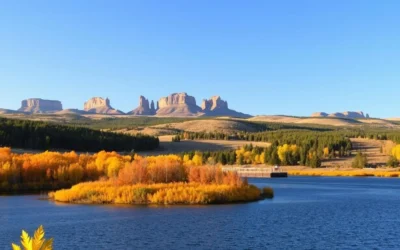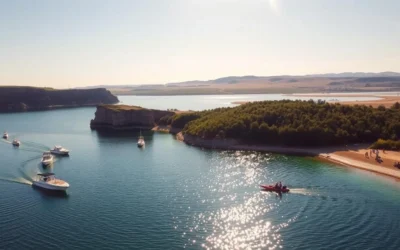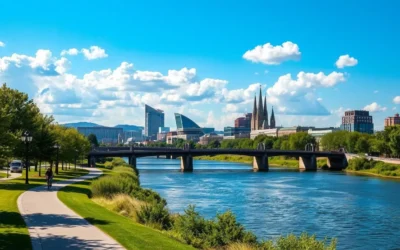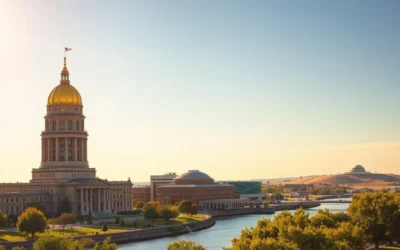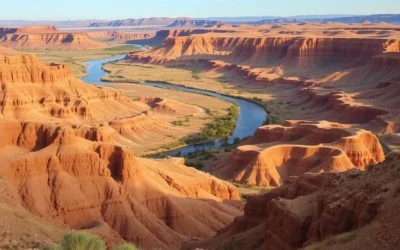✓ Accommodations ✓ Flights ✓ Rental Cars ✓ Tours & Activities
When planning a trip to North Dakota, understanding the state’s seasonal changes is crucial. The state’s continental climate means you will experience four distinct seasons, each with its unique charm and activities.
With vast prairies and dramatic badlands, North Dakota transforms throughout the year. The weather plays a significant role in shaping your travel experience, from warm summer days to snowy winter landscapes.
Choosing the best time to visit North Dakota depends on your preferences and the activities you have planned. As you prepare for your trip, considering the weather patterns and seasonal activities will help you make the most of your adventure in this unique state.
Understanding North Dakota’s Distinct Seasons
North Dakota experiences a continental climate, characterized by significant variations in temperature and precipitation throughout the seasons. This climate type is marked by hot summer days and extremely cold winter nights.
Continental Climate Characteristics
The state’s continental climate is known for its extremes. North Dakota has the coldest winters in the contiguous United States, with temperatures often dropping well below zero. In contrast, summer days can be quite warm.
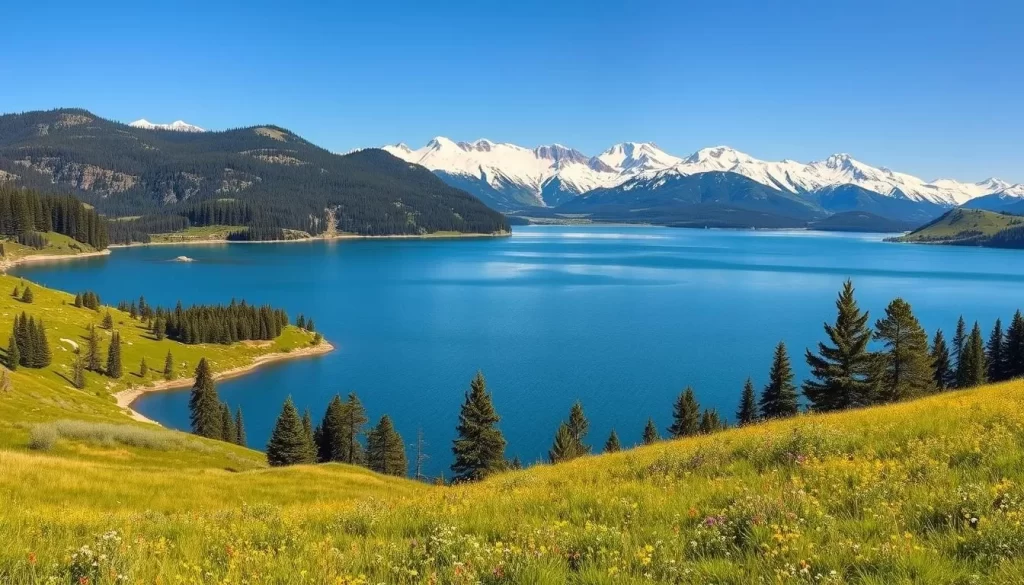
How Geography Affects Weather Patterns
North Dakota’s geography plays a crucial role in its weather patterns. The state’s vast flatlands allow strong winds to sweep across, intensifying both summer heat and winter cold. Additionally, the Missouri River valley and the western Badlands create microclimates that differ from the general weather patterns.
North Dakota, United States: Best Months for a Weather-Savvy Trip
The best months to visit North Dakota are those that offer the most pleasant weather conditions for outdoor activities. Late spring to early fall is considered the ideal period.
Late Spring to Early Fall (May-October)
During this period, the weather is comfortably warm, making it perfect for exploring the state’s outdoor attractions like Theodore Roosevelt National Park and the Maah Daah Hey Trail. The weather in North Dakota during these months avoids the harsh winter temperatures and showcases a vibrant display of local flora and fauna.
The best weather in North Dakota is between May and September, with the summer season bringing warmer temperatures ideal for outdoor adventures.
Benefits of Visiting During Shoulder Seasons
Visiting North Dakota during the shoulder seasons (May-June and September-October) has several advantages. You’ll enjoy lower accommodation rates, fewer tourists, and more comfortable temperatures for hiking and sightseeing.
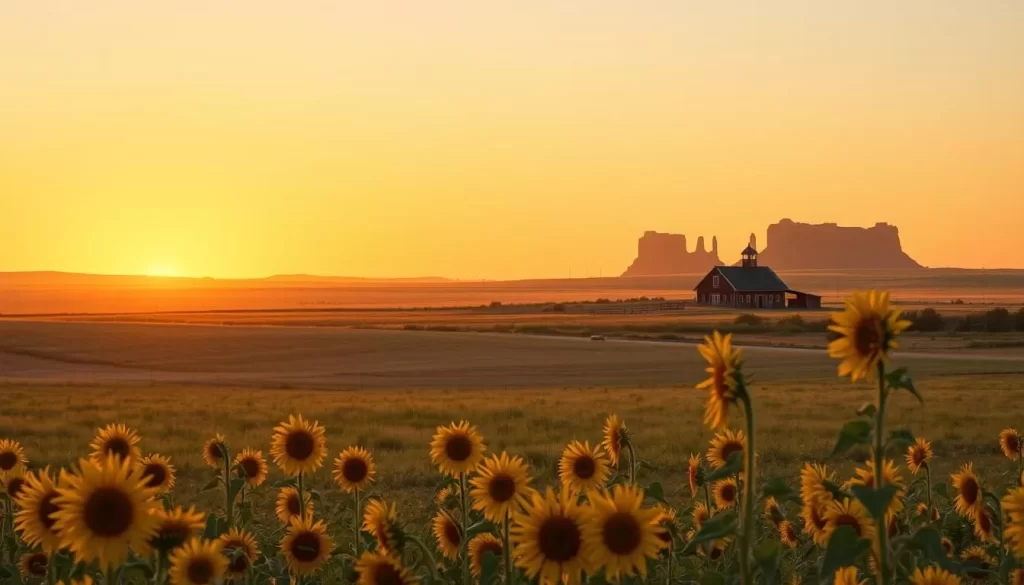
These months create ideal conditions for exploring the state’s national parks, historic sites, and natural attractions. Planning your trip to North Dakota around the state’s best weather windows will maximize your enjoyment of outdoor activities.
Summer in North Dakota: Peak Season Experience
North Dakota’s summer season is a peak time for tourism, offering a unique blend of outdoor experiences and cultural events. During this time, the state is at its most vibrant, with warm weather and a wide range of outdoor activities that attract visitors from all over.
June through August Weather Overview
The summer months in North Dakota are characterized by warm temperatures, with July being the hottest month, averaging 27°C/81°F. There are about 7 days of rainfall during this period. The days are long and warm, but the sun can be intense due to the lack of tree cover.
Outdoor Activities and Natural Attractions
Summer is an ideal time to engage in various outdoor activities such as hiking in Theodore Roosevelt National Park, fishing in Lake Sakakawea, and camping. The state’s natural attractions, including the Badlands and Pembina Gorge, are best experienced during this season.

Summer Festivals and Events
The summer season hosts a variety of festivals and events, including the North Dakota State Fair, the Medora Musical, and the Dickinson Roughrider Days. These events offer a glimpse into the state’s culture and are a great way to experience the local community.
| Event | Location | Date |
|---|---|---|
| North Dakota State Fair | Fargo | July-August |
| Medora Musical | Medora | June-September |
| Dickinson Roughrider Days | Dickinson | Late June-Early July |
Fall and Spring: The Perfect Balance
For those planning to visit North Dakota, the shoulder seasons present an ideal opportunity to experience the state’s natural beauty. During these periods, the weather is mild, and the crowds are smaller, making it an excellent time for outdoor activities.
September-October: Fall Colors and Harvest Season
Visiting North Dakota in September is a delightful experience as you catch the tail end of summer with the crisp onset of fall. The state’s landscapes begin to burst with autumn colors, making it a picturesque time to visit. You’ll enjoy special fall events like the Norsk Høstfest and the United Tribes International Powwow, showcasing the state’s rich cultural heritage.
- The prairies and woodlands display vibrant autumn colors.
- Agricultural regions celebrate harvest season.
- Wildlife viewing opportunities include bird migrations and increased animal activity.
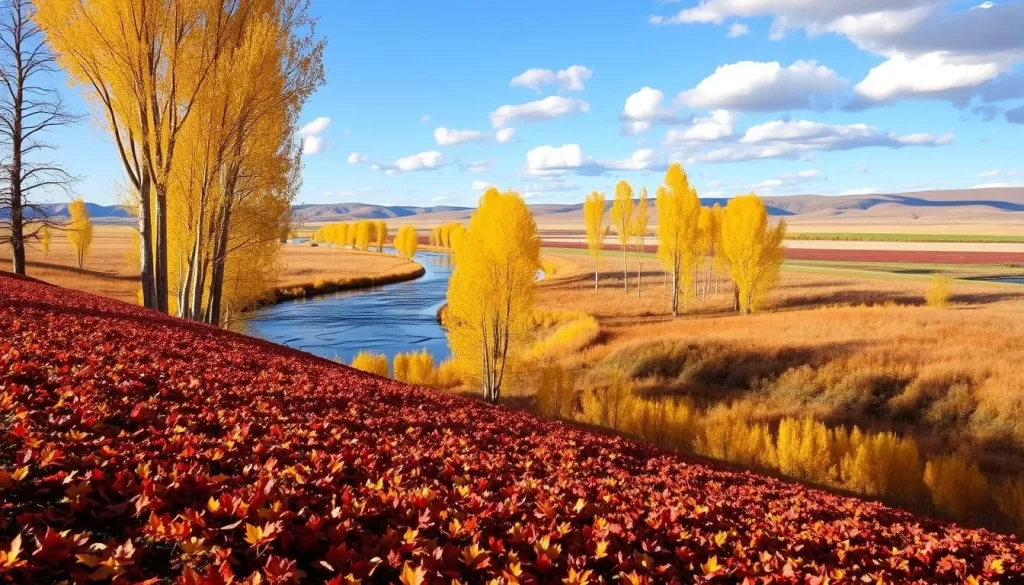
April-May: Wildlife Awakening and Spring Blooms
In April, North Dakota shakes off its winter chill, and you’ll witness the blooming of wildflowers and the bustling wildlife preparing for summer. It’s a perfect time for outdoor activities before the heat of summer sets in. Bird watching is particularly good during spring as migratory birds return.
- The landscape awakens with fresh greenery and wildflowers.
- Spring brings a remarkable transformation to the state’s wildlife.
- Moderate temperatures and fewer crowds enhance the visit.
Winter in North Dakota: For the Adventurous Traveler
Winter in North Dakota is a season of extremes, but for those willing to brave the cold, it’s an opportunity to experience the state’s rugged beauty. The winter months, from November to March, bring harsh weather conditions, with average temperatures ranging from -12°C to -20°C (10°F to -4°F). The strong winds and blowing snow can make travel challenging, but for adventure-seekers, this is part of the allure.
Cold Weather Conditions
During the winter months, North Dakota experiences some of its coldest temperatures. The average temperature in January, the coldest month, is around -12°C (10°F). It’s essential to pack warm clothing, including layers, insulated footwear, and cold-weather accessories, to stay safe and comfortable. The table below summarizes the average winter temperatures and snowfall in North Dakota.
| Month | Average Temperature (°C) | Average Snowfall (cm) |
|---|---|---|
| December | -10 | 20 |
| January | -12 | 25 |
| February | -10 | 22 |
Winter Activities and Attractions
Despite the cold, North Dakota offers a range of exciting winter activities, including ice fishing, snowmobiling, and cross-country skiing. Visitors can enjoy the beautiful winter landscapes, from snow-covered prairies to the frozen scenery of the Badlands. For those looking for a refuge from the cold, there are various indoor museums and cultural sites to explore. The
For winter sports enthusiasts, the Frost Fire Winter Park offers skiing and snowboarding opportunities. Whether you’re looking for adventure or just want to experience the unique beauty of North Dakota’s winter, there’s something for everyone.
Essential Travel Tips for Your North Dakota Adventure
Your North Dakota adventure can be significantly enhanced by being aware of a few essential travel tips. When visiting North Dakota, it’s crucial to be prepared for the state’s diverse weather conditions and geographical spread.
Transportation and Accommodation: Renting a car is often the best way to explore North Dakota comprehensively, as public transportation can be limited outside major cities like Fargo and Bismarck. You’ll find a range of accommodation options, from hotels in larger cities to unique lodgings near attractions like Theodore Roosevelt National Park.
Packing and Safety: Dressing in layers is key due to the state’s variable temperature swings. Additionally, be aware of cell phone coverage in rural areas and take necessary safety precautions when traveling through wide-open spaces.
By being informed and prepared, you can fully enjoy North Dakota’s outdoor activities, wildlife viewing opportunities, and cultural experiences, making your trip a memorable one.
The above is subject to change.
Check back often to TRAVEL.COM for the latest travel tips and deals.

